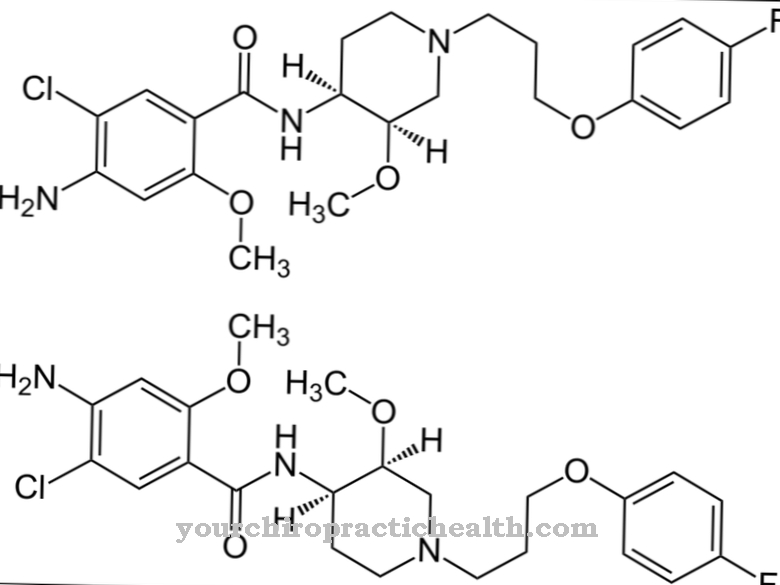Suxamethonium or. Succinylcholine is a depolarizing muscle relaxant related to acetylcholine. It is used in anesthesia to induce temporary relaxation of the muscles. It acts on the nicotinic Ach receptor (acetylcholine receptor) of the muscular endplate, where it leads to permanent depolarization.
What is Suxamethonium?
Suxamethonium (chemical name: 2,2 ′ - [(1,4-Dioxobutane-1,4-diyl) bis (oxy)] bis (N, N, N-trimethylethanaminium)) is an analogue of Curare, a strong neurotoxin. Suxamethonium is a depolarizing muscle relaxant and acts as an agonist on the muscular nicotinic Ach receptor. It is the only depolarizing muscle relaxant that is used in human medicine.
Acetylcholine is usually a neurotransmitter that is released by nerve cells at the synapses to muscle cells to induce depolarization and thus movement of the muscle. The acetylcholine is broken down as quickly as it binds to the receptors.
Succinylcholine has a similar effect to acetylcholine, but the difference is that it is not broken down again and thus causes constant depolarization. The muscle relaxes after a while, which is why suxamethonium is often used in anesthesia to relax patients so that they can then be ventilated, because the agent also affects the respiratory muscles.
Suxamethonium is the salt of succinic acid (succinate), which is esterified at both ends with a choline residue. This creates two positive charges. For this reason, the suxamethonium is given with two negatively charged chloride ions in order to achieve a neutral state.
Pharmacological effect on the body and organs
Acetylcholine serves as a neurogenic transmitter for intercellular communication. It is packed in vesicles in the motor neurons and is released into the synaptic cleft when there is a signal. It binds to nicotinic receptors in the muscular endplate. After successful binding, a channel is opened which is coupled to the receptor to which the acetylcholine binds. This channel mainly lets through positively charged ions such as sodium and potassium, but also negatively charged chloride ions. These flow along a gradient, either into or out of the muscle cell. The typical ion current occurs.
Because the gradient for sodium that leads into the cell is greatest, the muscle cell is charged more and more positively, since sodium is a positively charged ion. The cell depolarizes, creating a so-called excitatory postsynaptic potential (EPSP for short). If this EPSP reaches a certain threshold potential, an action potential can arise. This action potential spreads further on the muscle and finally leads to muscle twitching via further processes. To terminate the depolarization on the muscular endplate, acetylcholine is cleaved by acetylcholinesterase. The fission products are taken up again in the nerve cell.
Suxamethonium has a similar structure to acetylcholine, i.e. the process of a muscle twitch is exactly the same. The only difference is that the suxamethonium is not broken down by acetylcholinesterase. As a result, it remains bound to the muscular receptor and permanent depolarization occurs. Normally, after a depolarization, the receptor is transferred to an inactive state from which it recovers after a short time and is ready for another depolarization. However, due to the permanent depolarization, the receptor remains in the inactive state, and the excitation block occurs. An initial muscle twitch is followed by relaxation.
Medical application & use for treatment & prevention
Suxamethonium is used as a depolarizing muscle relaxant, especially in anesthesia. It is mainly used when brief muscle relaxations are required. Because suxamethonium only has a short duration of action of 10 minutes, but the onset of action is already recorded after one minute. Repeated use of the suxamethonium is necessary for longer operations.
It is used for intubation during induction of anesthesia, as it makes it easier for the tube to be inserted into the windpipe. Suxamethonium is also used to relax ventilated patients. It is also used in anesthesia as the agent of choice for induction of anesthesia in non-fasting patients, who thereby carry an increased risk of vomiting and aspiration of the stomach contents. This is known as "Rapid Sequence Induction", i.e. a quick process of induction of anesthesia.
Another indication is to reduce muscle contractions during seizures. Genetic variants of pseudocholinesterase pose a problem. This enzyme breaks down suxamethonium and thus dissolves muscle relaxation. One in 2500 patients has an insufficient amount of pseudocholinesterase due to a genetic defect. As a result, the suxamethonium works longer for those affected and accordingly they have to be ventilated longer. Suxamethonium is given as a solution for injection.
You can find your medication here
➔ Medicines for painRisks & side effects
Some patients are less able to break down suxamethonium because they lack the enzyme pseudocholinesterase. This leads to life-threatening muscular blockages in the respiratory muscles. The brief muscle twitching at the beginning of the suxamethonium administration can, depending on the strength, lead to the destruction of several muscle cells. The potassium in the cells can leak and lead to cardiac arrhythmias and other cardiovascular problems.
Other side effects include an increase in intraocular pressure, which is why it should not be used for known glaucoma. Some patients complain of muscle pain that lasts for days after the operation, which resembles sore muscles. In these rarest cases, administration of suxamethonium leads to malignant hyperthermia. It is characterized by the fact that a permanent contracture of the muscle fibers increases the body temperature massively. For this reason, patients with muscle disorders (such as muscular dystrophy) should not be treated with suxamethonium.
Suxamethonium should also not be used in patients who have an unstable cell membrane, for example from burns and injuries. Patients who have been immobilized for a long time should also avoid the active ingredient, as it increases the sensitivity of the Ach receptors.



























